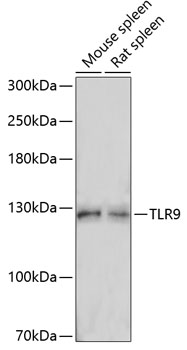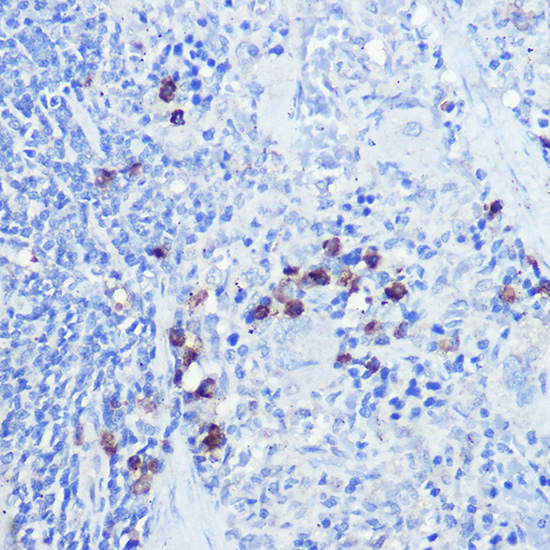Immunology Antibodies 1
Anti-TLR9 Antibody (CAB14642)
- SKU:
- CAB14642
- Product Type:
- Antibody
- Reactivity:
- Human
- Reactivity:
- Mouse
- Reactivity:
- Rat
- Host Species:
- Rabbit
- Isotype:
- IgG
- Antibody Type:
- Polyclonal Antibody
- Research Area:
- Immunology
Description
| Antibody Name: | Anti-TLR9 Antibody |
| Antibody SKU: | CAB14642 |
| Antibody Size: | 20uL, 50uL, 100uL |
| Application: | WB IHC |
| Reactivity: | Human, Mouse, Rat |
| Host Species: | Rabbit |
| Immunogen: | A synthetic peptide corresponding to a sequence within amino acids 350-450 of human TLR9 (NP_059138.1). |
| Application: | WB IHC |
| Recommended Dilution: | WB 1:500 - 1:2000 IHC 1:50 - 1:200 |
| Reactivity: | Human, Mouse, Rat |
| Positive Samples: | Mouse spleen, Rat spleen |
| Immunogen: | A synthetic peptide corresponding to a sequence within amino acids 350-450 of human TLR9 (NP_059138.1). |
| Purification Method: | Affinity purification |
| Storage Buffer: | Store at -20'C. Avoid freeze / thaw cycles. Buffer: PBS with 0.02% sodium azide, 50% glycerol, pH7.3. |
| Isotype: | IgG |
| Sequence: | SFAH LSLA PSFG SLVA LKEL DMHG IFFR SLDE TTLR PLAR LPML QTLR LQMN FINQ AQLG IFRA FPGL RYVD LSDN RISG ASEL TATM GEAD GGEK VWLQ P |
| Gene ID: | 54106 |
| Uniprot: | Q9NR96 |
| Cellular Location: | Cytoplasmic vesicle, Endoplasmic reticulum membrane, Endosome, Lysosome, Single-pass type I membrane protein, phagosome |
| Calculated MW: | 109kDa/114kDa/115kDa/118kDa |
| Observed MW: | 125kDa |
| Synonyms: | TLR9, CD289 |
| Background: | The protein encoded by this gene is a member of the Toll-like receptor (TLR) family which plays a fundamental role in pathogen recognition and activation of innate immunity. TLRs are highly conserved from Drosophila to humans and share structural and functional similarities. They recognize pathogen-associated molecular patterns (PAMPs) that are expressed on infectious agents, and mediate the production of cytokines necessary for the development of effective immunity. The various TLRs exhibit different patterns of expression. This gene is preferentially expressed in immune cell rich tissues, such as spleen, lymph node, bone marrow and peripheral blood leukocytes. Studies in mice and human indicate that this receptor mediates cellular response to unmethylated CpG dinucleotides in bacterial DNA to mount an innate immune response. |
| UniProt Protein Function: | TLR9: Key component of innate and adaptive immunity. TLRs (Toll-like receptors) control host immune response against pathogens through recognition of molecular patterns specific to microorganisms. TLR9 is a nucleotide-sensing TLR which is activated by unmethylated cytidine-phosphate-guanosine (CpG) dinucleotides. Acts via MYD88 and TRAF6, leading to NF-kappa-B activation, cytokine secretion and the inflammatory response. Controls lymphocyte response to Helicobacter infection. Interacts with MYD88 via their respective TIR domains. Interacts (via transmembrane domain) with UNC93B1. Interacts with CD300LH; the interaction may promote full activation of TLR9-triggered innate responses. Interacts with BTK. Interacts with CNPY3 and HSP90B1; this interaction is required for proper folding in the endoplasmic reticulum. Highly expressed in spleen, lymph node, tonsil and peripheral blood leukocytes, especially in plasmacytoid pre- dendritic cells. Levels are much lower in monocytes and CD11c+ immature dendritic cells. Also detected in lung and liver. Belongs to the Toll-like receptor family. 5 isoforms of the human protein are produced by alternative splicing. |
| UniProt Protein Details: | Protein type:Receptor, misc.; Membrane protein, integral Chromosomal Location of Human Ortholog: 3p21.3 Cellular Component: apical plasma membrane; basolateral plasma membrane; cytoplasm; endoplasmic reticulum; endoplasmic reticulum membrane; endosome; endosome membrane; Golgi membrane; lysosome; plasma membrane Molecular Function:1-phosphatidylinositol-3-kinase activity; interleukin-1 receptor binding; siRNA binding Biological Process: activation of NF-kappaB transcription factor; axonogenesis; defense response to Gram-negative bacterium; I-kappaB phosphorylation; inhibition of NF-kappaB transcription factor; innate immune response; maintenance of gastrointestinal epithelium; negative regulation of interleukin-6 production; negative regulation of interleukin-8 production; negative regulation of toll-like receptor signaling pathway; positive regulation of chemokine production; positive regulation of granulocyte macrophage colony-stimulating factor production; positive regulation of I-kappaB kinase/NF-kappaB cascade; positive regulation of inflammatory response; positive regulation of interferon-alpha biosynthetic process; positive regulation of interferon-beta biosynthetic process; positive regulation of interferon-beta production; positive regulation of interferon-gamma biosynthetic process; positive regulation of interleukin-10 production; positive regulation of interleukin-12 production; positive regulation of interleukin-18 production; positive regulation of interleukin-6 production; positive regulation of interleukin-8 production; positive regulation of JNK activity; positive regulation of JNK cascade; positive regulation of NF-kappaB import into nucleus; positive regulation of nitric-oxide synthase biosynthetic process; positive regulation of toll-like receptor signaling pathway; positive regulation of transcription from RNA polymerase II promoter; positive regulation of tumor necrosis factor production; response to molecule of bacterial origin; toll-like receptor 9 signaling pathway; toll-like receptor signaling pathway; tumor necrosis factor production |
| NCBI Summary: | The protein encoded by this gene is a member of the Toll-like receptor (TLR) family which plays a fundamental role in pathogen recognition and activation of innate immunity. TLRs are highly conserved from Drosophila to humans and share structural and functional similarities. They recognize pathogen-associated molecular patterns (PAMPs) that are expressed on infectious agents, and mediate the production of cytokines necessary for the development of effective immunity. The various TLRs exhibit different patterns of expression. This gene is preferentially expressed in immune cell rich tissues, such as spleen, lymph node, bone marrow and peripheral blood leukocytes. Studies in mice and human indicate that this receptor mediates cellular response to unmethylated CpG dinucleotides in bacterial DNA to mount an innate immune response. [provided by RefSeq, Jul 2008] |
| UniProt Code: | Q9NR96 |
| NCBI GenInfo Identifier: | 20140872 |
| NCBI Gene ID: | 54106 |
| NCBI Accession: | Q9NR96.2 |
| UniProt Secondary Accession: | Q9NR96,Q6UVZ2, Q9HD68, Q9HD69, Q9HD70, Q9NYC2, Q9NYC3 B3Y661, D1CS56, |
| UniProt Related Accession: | Q9NR96 |
| Molecular Weight: | 114,237 Da |
| NCBI Full Name: | Toll-like receptor 9 |
| NCBI Synonym Full Names: | toll like receptor 9 |
| NCBI Official Symbol: | TLR9 |
| NCBI Official Synonym Symbols: | CD289 |
| NCBI Protein Information: | toll-like receptor 9 |
| UniProt Protein Name: | Toll-like receptor 9 |
| UniProt Synonym Protein Names: | CD_antigen: CD289 |
| Protein Family: | Toll-like receptor |
| UniProt Gene Name: | TLR9 |
| UniProt Entry Name: | TLR9_HUMAN |










